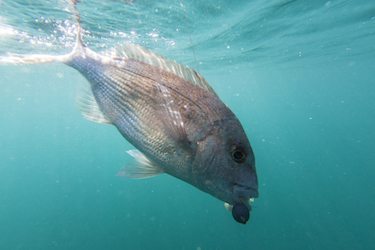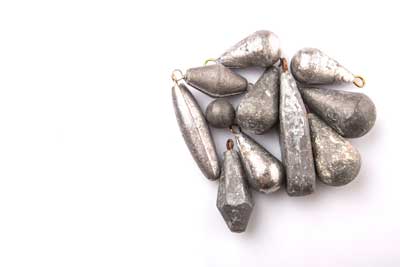How to Choose the Best Types of Fishing Weights

Sinkers are used to cast, sink, anchor, troll and pretty much control how the bait enters the water and behaves once it’s there.
*In fresh water, bullet shaped worm sinkers are used by bass anglers who fish for largemouth bass with texas-rigged plastic worms.
General purpose sinkers
Because most bottom heavy sinkers cast and sink well they are perfect for all-round general purpose weight tackle.
In contrast the flat bank or diamond sinkers don’t cast well at all and therefore are not recommended as a general purpose sinker.
Bell shaped, pear shaped or bass-casting sinkers roll around a lot in the current. It’s important to understand they’ll behave in this way even if they’re resting on the bottom.
This is a guide to all types of fishing weights.
The links below will take you directly to information on those weights.
[sta_anchor id=”casting”]1. Casting[/sta_anchor]
- The most accurate sinker is one that is streamlined, compact and bottom heavy.
- Air and water resistance as well as line drag will provide the greatest interference. With a properly balanced tackle, we need only be concerned with resistance.
- To provide the least degree of drag, we recommend the teardrop shaped weight.
- Avoid bulky sinkers. Those that are not bottom heavy tend to flop around and won’t go as far.
- Thin and flat sinkers should also be avoided as they’ll cause the lure to enter the water wide or short.
[sta_anchor id=”sinking”]2. Sinking[/sta_anchor]
- best is streamlined, tear-drop shaped
Where currents are a factor use a heavier sinker to drop it closer to where you want your bait. However avoid being too heavy as it will affect line sensitivity.
[sta_anchor id=”anchoring”]3. Anchoring[/sta_anchor]
A flat sinker anchors well in a soft sandy bottom compared to angular sinkers that will dig in. These weights will increase water and air resistance which means that these weights won’t be as accurate as sinkers. Aim where you think the bait will enter the water and where you want it to be.
On broken floor beds, use a heavy sinker and avoid anything that will embed on the bottom.
[sta_anchor id=”drifting”]4. Drifting[/sta_anchor]
The condition of the bottom makes a huge difference. Most sinkers can be used on a clean floor. If you’re not sure of the floor condition, bank on it being broken.
Drift Sinkers
Pencil styled sinkers are good for drifting, trolling and dragging across the bottom without getting caught up in debris.
- Good drift sinkers are cylindrical or pretty much spoon shaped
- Avoid sinkers that tend to tangle the line or cause undue movement because these will put the fish off the bait
[sta_anchor id=”trolling”]5. Trolling[/sta_anchor]
A requirement for trolling is that the bait must be held at the desired level and that the sinker doesn’t cause any movement to the bait.
Trolling Sinkers
Trolling sinkers should be streamlined, which will reduce water resistance and dive deeper than the weight would normally go if it were not streamlined.
A good weight will hang below that of the line and a swivel may be used which can reduce line twisting.
Trolling sinkers are characterized by well-balanced design and have a geometric design. Lead rudders combine the well-balanced design of the trolling rudder with the weight of a sinker.
Other useful trolling sinkers include the various versions of the crescent sinkers, also known as banana sinkers.
- The bank sinker is very aerodynamic and shoots pretty much in a straight line and it works well as a trolling sinker.
Salmon trollers prefer to use the heavy cannonball sinkers. They have them rigged on strike release clips, which drops the weight when the fish strikes.
Diving weights come in either delta winged or diving planers. The advantage of these is that they can take the weight lower than it would normally go. The weights are balanced well enough that when a fish strikes, it will cause the planer to climb towards the surface.
[sta_anchor id=”rigging-sinkers” unsan=”rigging sinkers”]6. Rigging Sinkers[/sta_anchor]
When your line gets snagged often the sinker is the culprit. Some anglers create a break-away sinker that if snagged will fall away from the line allowing the retrieval of the lure.
[sta_anchor id=”how-to-make-a-breakaway” unsan=”how to make a breakaway”]How to make a breakaway[/sta_anchor]
- Take a dropper line that tests lighter than your main line.
- Using a separate length, tie a knot in the middle of it. The overhand knot will create a weakening of the line by between 20 and 60 percent.
There are many other ways to create a breakaway line and some testing is recommended before trying this.
[sta_anchor id=”soft-bottom-sinkers” unsan=”soft bottom sinkers”]7. Soft Bottom Sinkers[/sta_anchor]
Soft bottom sinkers are designed to work well on sandy bottoms. The pyramid sinker is wide with angular shoulders that make it a good anchor. The downside is that being top heavy they don’t cast very well and create a lot of air resistance.
[sta_anchor id=”in-line-slip-sinkers” unsan=”in-line slip sinkers”]8. In-Line Slip Sinkers[/sta_anchor]
Another popular in-line sinker is the egg sinker which is common through North America. The open-eyelet sinker is also popular.
[sta_anchor id=”in-line-fixed-sinker” unsan=”in-line fixed sinker”]9. In-Line Fixed Sinker[/sta_anchor]
We’re not a big fan of torpedo or cigar fixed sinkers as they tend to get the line tangled. However, the Carolina worm weight is less susceptible to snagging in weeds.
Tuning Sinker Split shots are a good example of a tuning sinker as they can be used to fine tune a lure or bait by allowing the addition of minute amounts of weight.
- A good way to fix them to a line is to take a small portion of the line, wrap it around and snap on the sinkers to hold it all together. As a result it allows them to be easily removed as well.
Note: Lead based split shot, while popular years ago, are being banned in many countries due to the toxic nature of lead.



